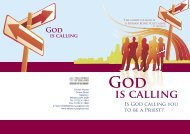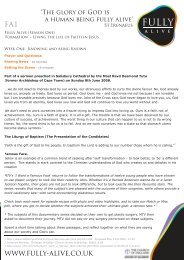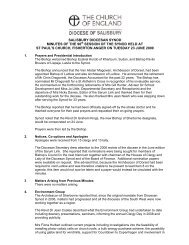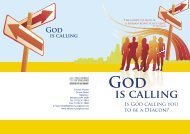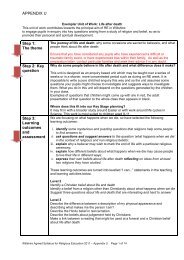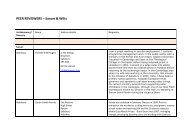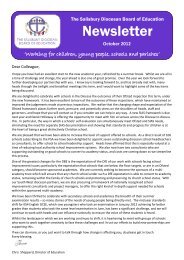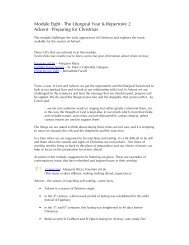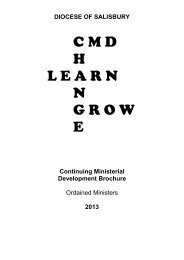You also want an ePaper? Increase the reach of your titles
YUMPU automatically turns print PDFs into web optimized ePapers that Google loves.
<strong>MODULE</strong> <strong>10</strong> - <strong>Morning</strong> <strong>and</strong> <strong>Evening</strong> <strong>Prayer</strong>Recommended preparatory reading.Introduction by Andrew Burnham to Using Common Worship – Daily <strong>Prayer</strong>, A PracticalGuide to the New Services, by Jeremy Fletcher <strong>and</strong> Gilly Myers, CHP 2002.Canonical HoursCathedral Officefrom A New Dictionary of Liturgy <strong>and</strong> Worship, ed. J.G. Davies, SCM Press 1994.About this ModuleThis module deals with the origins <strong>and</strong> historical developments that have formed ourservices of <strong>Morning</strong> <strong>and</strong> <strong>Evening</strong> <strong>Prayer</strong>. It also lists what parts of the services requiremusical settings.‘From earliest times Christians gathered at regular hours during each day <strong>and</strong> night torespond to God’s word with praise on behalf of all creation <strong>and</strong> with intercession for thesalvation of the world. By the fourth century, if not earlier, morning <strong>and</strong> evening hademerged as the pre-eminent hours for the offering of this sacrifice of praise. They haveremained so ever since, especially on Sundays when the Church commemorates both thefirst day of creation <strong>and</strong> the day of Christ’s resurrection.‘From the introduction to <strong>Morning</strong> <strong>and</strong> <strong>Evening</strong> <strong>Prayer</strong> on Sunday fromCommon Worship, Services <strong>and</strong> <strong>Prayer</strong>s for the Church of Engl<strong>and</strong>.We have inherited these two forms of worship which have evolved through a turbulenthistory <strong>and</strong> that now take a firm place in both our daily <strong>and</strong> Sunday cycle of worship.We are more familiar with the form of evening prayer or ‘evensong’ <strong>and</strong> so you will belooking at how the service we use now came into being. You will also be looking at theservice called Night <strong>Prayer</strong> or Compline.Shape of the OfficeOn the following page is a layout of the two services that Thomas Cranmer used toconstruct Mattins <strong>and</strong> <strong>Evening</strong> <strong>Prayer</strong>. This shows how he formulated these services fromdifferent parts of the Roman Office.Evensong was structured to follow the shape of the new Mattins or <strong>Morning</strong> <strong>Prayer</strong> sothat both the services should be of a uniform design. The opening Sentences,Exhortation, Confession & Absolution were appointed, as at Mattins in 1552 but notprinted at the beginning of <strong>Evening</strong> <strong>Prayer</strong> until 1661.The Canticles are significant in that after the Old Testament reading, we have the Songof Mary, testifying to the fulfilment of God’s promises of mercy to the Fathers <strong>and</strong> afterthe New Testament reading we express our readiness to receive the Gospel in the songof the aged Simeon with the hope that we shall have peace in our death of which everynight brings a type in our sleep.The Second Collect for peace was in the Sarum Breviary as an <strong>Evening</strong> Memorial forPeace. The Third Collect was the Collect of Compline in the Sarum Breviary.
SARUM BREVIARYMATINSIntroductionVenite with InvitatoryPsalmHymnPsalms <strong>and</strong> AntiphonsLessons with RespondsTe Deum <strong>and</strong> VersicleLAUDSPsalms <strong>and</strong> CanticleChapterHymn <strong>and</strong> VersicleBenedictus with AntiphonSuffrages <strong>and</strong> CollectMemorialsMATTINSFIRST PRAYER BOOK1549IntroductionVenitePsalmsFirst LessonTe DeumSecond LessonBenedictusSuffrages, Creed <strong>and</strong> CollectCollects for peace <strong>and</strong> GraceSECOND PRAYER BOOK1552MATTINSSentencesExhortationConfession & AbsolutionIntroductionVenitePsalmsFirst LessonTe DeumSecond LessonBenedictusSuffrages, Creed <strong>and</strong> CollectCollects for peace <strong>and</strong>GraceVESPERSPrivate prayer <strong>and</strong>IntroductionFive Psalms withAntiphonsChapterRespondHymn <strong>and</strong> VersicleMagnificat with AntiphonCollectMemorialsCOMPLINEFour Psalms withAntiphonsChapterRespondHymn <strong>and</strong> VersicleNunc Dimittis withAntiphonCollectMemorialsEVENING PRAYERIntroductionPsalmsFirst LessonMagnificatSecond LessonNunc DimittisSuffrages, Creed <strong>and</strong> CollectCollects for Peace <strong>and</strong> GraceEVENING PRAYERSentencesExhortationConfession & AbsolutionIntroductionPsalmsFirst Lesson(optional Psalm 98)MagnificatSecond Lesson(optional Psalm 67)Nunc DimittisSuffrages, Creed <strong>and</strong> CollectCollects for Peace <strong>and</strong>Grace1661AnthemLitanyor Five Closing <strong>Prayer</strong>s
The rise of the Monastic OfficeIn the late Patristic <strong>and</strong> Early Medieval periods a style of worship was developed byMonastic establishments <strong>and</strong> this came to be dominant over what had been beforeThe earlier shape of worship (termed the Cathedral Office), featured Matins <strong>and</strong> Vesperseach day which themselves derived from Synagogue worship. There was added a vigil(or night office) before Sundays or Feast days which derived from the Paschal vigil of theearly church.In the fourth century, the rise of Monasticism developed a style of worship different tothis more public ‘secular’ worship which was based on the ideals <strong>and</strong> spirituality ofmonastic life.One of the more obvious differences found in the two styles of worship was the numberof services occurring during each day. In the older there were two, in the new seven oreight <strong>and</strong> known as the Canonical Hours:Matins & LaudsPrimeTerceSextNoneVespersComplineThis increase in the number of daily services from two or three to seven or eight <strong>and</strong> thestructure of these was to include the continuous daily reading of scripture over a givenperiod <strong>and</strong> the Psalter to be read once through every week, (now every 30 days - lectiocontinua).There were surviving remnants of the older practice in the West in Milan <strong>and</strong> Toledo. Inthe East, the Chaldean rite preserved some of the structure <strong>and</strong> content while theByzantine rite merged the two together, hence the excessive length of services! Withmonastic clergy taking hold of most high ranking posts in the church, the Roman patternbecame totally of monastic shape. This resulted in the formulation of the Roman Breviarywhich provided clergy with the orders for Matins, Lauds, Vespers <strong>and</strong> Compline <strong>and</strong>from which Cranmer drew for his Book of Common <strong>Prayer</strong>. The model he used was theSarum Breviary.After Cranmer, the clergy were provided with a less complicated form of daily worshipnow that monastic communities had ceased to exist. Dawn <strong>and</strong> dusk offices were reestablishedby later monastic communities in the 19 th <strong>and</strong> 20 th centuries.This less complicated way of ordering daily worship meant that less books were neededfor reference <strong>and</strong> the five separate books used to dictate what was read or sung duringthe Sarum Rite were now reduced <strong>and</strong> contained within one cover, the Booke ofCommon <strong>Prayer</strong>. Of course, a lot was lost, especially music which had to be formulatedas a later publication by John Merbecke.
Common Worship <strong>Morning</strong> & <strong>Evening</strong> <strong>Prayer</strong>‘These orders of service are … intended to help Christians of our own day take their partin this privilege <strong>and</strong> duty which belongs to all God’s priestly people. They may becelebrated in a variety of different ways, for example, as:• a simple form of prayer at the very beginning or end of the day;• the Gathering <strong>and</strong> Liturgy of the Word for another service which is to followimmediately;• the principal service of the day.‘To meet diverse needs such as these, they are very flexible in arrangement. The centralcore, however, consists of the Liturgy of the Word interwoven with canticles to supplythe response of praise, followed by intercessory prayer in one form or another. A varietyof alternative endings are provided in the form of thanksgivings for different aspects ofthe Church’s life. Whenever possible, the services should include some singing,especially of the Gospel canticle, which is the climax of the morning or evening praisefor the work of God in Christ. If desired, metrical paraphrases may be substituted for anyof the biblical canticles, <strong>and</strong> other hymns <strong>and</strong> songs may be added at appropriate points’From Introduction to <strong>Morning</strong> <strong>and</strong> <strong>Evening</strong> <strong>Prayer</strong> on Sunday fromCommon Worship, Services <strong>and</strong> <strong>Prayer</strong>s for the Church of Engl<strong>and</strong>.Unless you want to delve deeper into the origins of our present day services for morning<strong>and</strong> evening, you should now go on to looking at the following lists which flag up theopportunities for using music during these contemporary services. If you are not usingthe Church of Engl<strong>and</strong> Common Worship <strong>Prayer</strong> Book, you can refer to your own <strong>Prayer</strong>Book to make a similar list. A useful opportunity to compare these with others may beavailable on the website bulletin board.Note that we are looking at the new services that have been recently produced <strong>and</strong> notat Mattins <strong>and</strong> Evensong from the 1662 Book of Common <strong>Prayer</strong>. You will probably befamiliar with the 1662 forms if you have visited a Cathedral recently. Here choirs stillregularly use the older version <strong>and</strong> the there is much support for the opportunity to usethis text <strong>and</strong> associated musical settings of Responses, Psalms, Canticles <strong>and</strong> theinclusion of an Anthem.The forms below are more likely to be used by churches with more modest musicalforces <strong>and</strong> where there is a need for less formality <strong>and</strong> a need for outreach to the localcommunity.It would be useful if you were to have a copy of the services to refer to. If you use thethe following link, you can order a booklet containing these texts.http://www.chbookshop.co.uk/product.asp?id=6717
THE ORDER FOR MORNING PRAYER ON SUNDAYSItems for which music may be used:Versicles <strong>and</strong> Responses.An opening Canticle or a hymn may be said or sung (see Note 4 below).The appointed psalmody is said or sung.Old Testament Canticle (see Note 5 below).Suitable song or chant to follow Scripture Readings, or a Responsary.Gospel Canticle – Benedictus (see Note 6 below).Thanksgiving (optional).Affirmation of Faith.Intercessions.The Lord’s <strong>Prayer</strong>.Conclusion (see Note 9 below).Notes1 Hymns <strong>and</strong> songs may be sung at appropriate points in the service, <strong>and</strong> metricalparaphrases may be used in place of the biblical canticles.4 Opening Canticle at <strong>Morning</strong> <strong>Prayer</strong> The following are suitable for use as theopening canticle: Benedicite, A Song of Creation, especially in ordinary time;Jubilate, A Song of Joy, especially in festal seasons; The Easter Anthems,especially during the Easter season; <strong>and</strong> Venite, A Song of Triumph, especiallyduring Advent <strong>and</strong> Lent.5 Old Testament Canticles The following are suitable as Old Testament canticles at<strong>Morning</strong> <strong>Prayer</strong>, especially in the seasons indicated:A Song of the Wilderness(Advent)A Song of the Messiah(Christmas)A Song of New Jerusalem(Epiphany)A Song of Humility(Lent)The Song of Moses <strong>and</strong> Miriam (Easter)A Song of Ezekiel(Pentecost)A Song of David(Ordinary time)6 Gospel Canticles Other translations of Benedictus, A Song of Zechariah may beused.9 The canticle Te Deum, A Song of the Church, may be used at <strong>Morning</strong> <strong>Prayer</strong>immediately before the Conclusion.
THE ORDER FOR EVENING PRAYER ON SUNDAYSItems for which music may be used:Versicles <strong>and</strong> Responses.An opening hymn may be sung. (See below).Psalmody Verses from Psalm 141 may be said or sung. (See below).The appointed psalm is said or sung.New Testament Canticle (see Note 5 below).Suitable song or chant to follow Scripture Readings, or a Responsory.Gospel Canticle – Magnificat.Thanksgiving (optional).Affirmation of Faith.Intercessions.The Lord’s <strong>Prayer</strong>.Conclusion (see Note 9 below).Notes2 Hymns <strong>and</strong> songs may be sung at appropriate points in the service, <strong>and</strong> metricalparaphrases may be used in place of the biblical canticles.5 New Testament Canticles The following are suitable as New Testament canticlesat <strong>Evening</strong> <strong>Prayer</strong>, especially in the seasons indicated:A Song of the SpiritA Song of RedemptionA Song of PraiseA Song of Christ the ServantA Song of FaithA Song of God’s ChildrenA Song of the Lamb(Advent)(Christmas)(Epiphany)(Lent)(Easter)(Pentecost)(Ordinary time)6 Gospel Canticles - other translations of Magnificat, A Song of Mary may be used.7 Opening Hymn at <strong>Evening</strong> <strong>Prayer</strong> Translations of the ancient Phos Hilaron, ASong of the Light, together with examples of other hymns, songs <strong>and</strong> chantssuitable as the opening hymn at <strong>Evening</strong> <strong>Prayer</strong>. (See list below).8 Psalm 141 at <strong>Evening</strong> <strong>Prayer</strong> – see below.9 Te Deum The canticle Te Deum, A Song of the Church, may be used at <strong>Evening</strong><strong>Prayer</strong> immediately before the Conclusion.Suitable Hymns <strong>and</strong> Songs celebrating the light of God in Christ:Christ, be our Light (Farrell)Christ, Mighty Saviour, Light of all Creation (HPP 256)Christ is the World’s Light (Laudate 744)Christ is the World’s True Light (NHWS T5/T6)Christ Whose Glory Fills the Skies (BBC Songs of Praise 143)Come my Way (TCH 21)Creator of the Stars of Night (Laudate 87)From the Very Depths of Darkness (NHWS 69)Hail Gladdening Light (HCS 330/NHWS 93)
Jesus, You are the radiance (SOF 312)Kindle a Flame (Iona-HSNW)Light of Gladness (HPP 244/Laudate 15)Lighten Our Darkness (SOF 340)Light Has Dawned (SOF 341/MP422)Light of the World (SOF 342)Light of the Minds that Know Him (in Lift Every Heart - Dudley-Smith)Longing For Light (Farrell, Laudate 883)Lord the Light of Your Love (MP445)Now it is <strong>Evening</strong> (Laudate 675)O God Who Shaped the Starry Skies (GITG p.34)O Gladsome Light (HCS 331)O Gracious Light (HPP 242/Laudate 14)O Light Serene (HPP243)O Blest Creator, God Most High (HPP 245)O Blest Creator, Source of Light (HPP 246)O Trinity of Blessed Light (HPP 252)O Blessed Uncreated Light (HPP 255)O Christ You are the Light of Day (HPP 261)O Lord of Every Shining Constellation (BBC Songs of Praise 14)The Light of Christ (Laudate 747)The Lord is My Light (Taizé)Veni Lumen Cordium (Taizé)We Sing the Lord our Light (in Lift Every Heart - Dudley-Smith)Sources for above:HPPNHWSTCHSOFHSNWMPGITGHCSHymns for <strong>Prayer</strong> & Praise (Canterbury Press)New Hymns <strong>and</strong> Worship Songs (Mayhew)The Cambridge Hymnal (CUP)Songs of Fellowship (Kingsway)Heaven Shall Not Wait (Iona)Mission Praise (Marshall Pickering)Great is the Glory – Dudley-Smith (Hope)Hymns for Church & School (Gresham Books)Psalm 141 at <strong>Evening</strong> <strong>Prayer</strong>This psalm is known as the ‘incense’ psalm for obvious reasons.Alternative music settings available for this psalm:Reginald Box SSFStephen DeanFr André GouzeMichael JoncasMusic for <strong>Evening</strong> <strong>Prayer</strong>, Hilfield FriaryLaudate, Decani MusicA Sunday Vigil, Les Editions de l’Abbaye de SylvanesLaudate, Decani MusicAs you can see from these lists, there are many opportunities to use music. The Psalms<strong>and</strong> Canticles are the main texts that you will have to provide music for. Of course, anytranslation of the psalms may be used as you would for scripture readings. This meansthat there is a very large range of material to choose from <strong>and</strong> you can explore this inModule 6 – Using Psalms in Worship.
Night <strong>Prayer</strong> (Compline)This ancient office seems to have survived the ravages of both time <strong>and</strong> reform. Theservice originates from the final ‘hour’ of the monastic day <strong>and</strong> where it would befollowed immediately by retiring to bed. In winter months, this would occur around5.00pm <strong>and</strong> in the summer, 7.30pm. This may seem early to us but the Benedictinecommunity would rise for Nocturns (Mattins) at 1.00am in the summer!You have already seen that parts of Compline were used by Cranmer in his structure for<strong>Evening</strong> <strong>Prayer</strong>, notably the use of the canticle Nunc Dimittis <strong>and</strong> evening collects.Night <strong>Prayer</strong> is a quiet <strong>and</strong> reflective service <strong>and</strong> its older title of Compline is derivedfrom the Latin completorium or completion.There is a great deal of psalmody that may be used <strong>and</strong> set psalms are given withalternatives if the service is used daily. Traditionally, the service is sung to plainchant withor without accompaniment. This form may be obtained from the Plainsong <strong>and</strong> MedievalMusic Society (PMMS), who publish a beautifully produced version in association withthe Royal School of Church Music (RSCM). A cantor is required <strong>and</strong> singers may use asimplified version or the more ornate settings which are well worth some preparation.Other settings of the psalmody <strong>and</strong> the Nunc Dimittis may be used <strong>and</strong> there aresettings of the prayer ‘Keep me as the apple of an eye’ available. The 5 th or 6 th centuryhymn Before the ending of the day (Te lucis ante terminum) can be sung to plainchant ora suitable Long Metre (8.8.8.8.) tune.Here is an extract from the PMMS/RSCM publication of the responsory, Into your h<strong>and</strong>sO Lord:
Next StageYou have now worked through this module <strong>and</strong> probably found that you need to discussthis material with others on the course. Please use the online forum for this. You canleave a question or comment on a ‘thread’ or start a thread which will then be added toby other students <strong>and</strong> tutors.As this is an important module in the course, you will now need to produce a piece ofwritten work which considers the subject in relation to your own experience in yourchurch.Don’t forget, this need not be an academic piece of writing, more a working out in yourown words, how these ideas relate to what actually happens where you worship <strong>and</strong>how they might change or confirm the choice of music for <strong>Morning</strong> or <strong>Evening</strong> <strong>Prayer</strong> atyour church.Further information about music resources for <strong>Evening</strong> <strong>Prayer</strong> will appear in the threemodules ‘The Liturgical Year <strong>and</strong> Repertoire’.Take your time to read some or all of the following recommended material. Discuss,explore <strong>and</strong> satisfy yourself that you have understood everything before moving on toyour next chosen module. If you have any questions, email Robert Fielding onrcfielding@googlemail.comReading material:Using Common Worship – Daily <strong>Prayer</strong>, A Practical Guide to the New Services, byJeremy Fletcher <strong>and</strong> Gilly Myers, CHP 2002.The Divine Office, in The Study of Liturgy (revised edition), SPCK 1993.A hard copy of material for use at <strong>Morning</strong> & <strong>Evening</strong> <strong>Prayer</strong> exists in Sarum CollegeLibrary, Salisbury (if you are able to visit).Robert FieldingRevised 20<strong>10</strong>This material copyright © Robert Fielding 20<strong>10</strong>.




